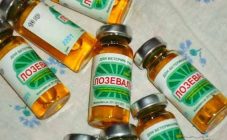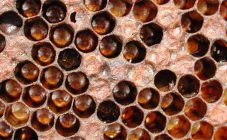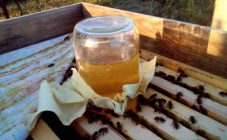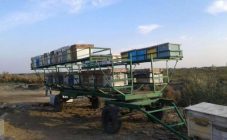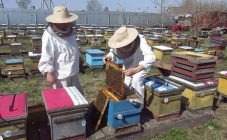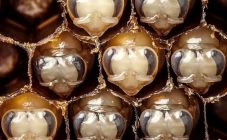Content:
Breeding bees and getting honey from them is not an easy task. Although these insects do not need daily care and supervision, they need to be given a lot of time. Despite the fact that bees are active for about 6 months a year, they should be watched even during the period when they are in hibernation. If the bees get sick, then it is generally recommended to pay attention to them daily. The most common and widespread bee disease is nosematosis. What is this disease?
Description of the disease of nosematosis
Nosema in bees is an invasive disease caused by an intestinal parasite. It affects, in most cases, adults, drones, bees, queens. This disease is widespread in the northern regions of Russia, due to the fact that there are long winters. Most often, the disease manifests itself in late winter or early spring. In simple terms, bee nosematosis is severe diarrhea. Infection with the disease occurs through the feces of insects. They contain parasitic spores, which are mixed with feed, as a result, they enter the intestines of healthy bees and begin to develop there.
Due to the fact that spores stop the intestinal walls of bees, protein food is less absorbed in them, respectively, there is a lack of vitamins. Further, the insect's body is poisoned by rotting products, which are formed from poorly digested food.
Other hives can get nosematosis with the help of thief bees or drones. The infected mother lays defective eggs, and internal organs are affected in her body. Drones born from an infected uterus will not be able to fertilize a female.
Symptoms
It is not so difficult to detect nosematosis in bees by symptoms and to treat it. At the end of winter, when the bees are mostly rather apathetic, they suddenly begin to fly chaotically and mark the walls of the hive with their feces, exude a characteristic smell. Stool leaves traces in the form of a dried brown film. The carriers of the disease look sluggish, their belly is greatly swollen, and wing tremors are observed.
With a long course of the disease, the legs of bees weaken, they cannot land and walk correctly. With unsuccessful attempts to gain a foothold with their paws, they fall to the surface. If this disease is not detected and treated in a timely manner, nosematosis can destroy the entire bee family, including the queen.
Treatment
Nosema in bees, symptoms and treatment are carried out in several stages and in a short time. First you need to get rid of the dead bees due to nosematosis. Then the insects move to a clean hive. An antibiotic called fumagillin is added to the feed. You can buy it at any specialty store. It is added to food, according to the instructions. Half a liter of sugar syrup with an antibiotic diluted in it is distributed to one family per day. The treatment takes place within 10 days.
Prevention of nosematosis
In order to minimize bee losses, nosematosis is easier to prevent. For this, a number of preventive measures are taken.In order to prevent disease, the fodder honey left to bees for the winter period should be floral. In the middle of autumn, it is recommended to feed the bees with sugar syrup.
Nosema multiplies and develops at temperatures of 15 ° C and above. Therefore, in order to prevent a disease such as nosematosis, the temperature should be maintained at about 4 ° C, the air humidity should be within 70%. These indicators are considered optimal. To relieve the intestines of insects in the first decade of February, they are fed with sugar candi cakes.
Diagnosis and course of nosematosis
During bee activity, nosematosis proceeds completely without symptoms. This disease destroys tissue in the intestines. The first symptoms appear two weeks after the Nosema is fixed in the bee's intestines. In an infected insect, the abdomen swells, diarrhea occurs, activity is replaced by passivity. Sick bees are unable to stay on their feet, fall from the honeycomb, the amount of collected nectar decreases. During the period of illness, bees have an increase in appetite, respectively, the amount of honey consumed increases. The peak of the disease occurs in mid-May.
Diagnosis of the disease is carried out with the help of 20 live bees, which are placed in a freezer for 30 minutes. This is done in order to reduce physical activity. Their intestines are removed. Normally, in healthy individuals, the intestine is pink, in patients it is clearly gray in color. The midgut is rubbed with a little water, then a drop of this mixture is placed under a microscope. Under the microscope, the spores of Nosema are very clearly visible. They look like a small grain of rice.
Wormwood from bee nosematosis
A folk remedy has proven itself very well from nosematosis: a tincture or a decoction of wormwood. This tincture can be made at home. To do this, the leaves and stems of wormwood are crushed, and half of a 3-liter bottle is filled with them. Next, the plant is filled with alcohol or vodka and infused for 5 days. In the case of a decoction, the crushed leaves and stems of the plant are filled with boiling water and infused for 24 hours.
The manifestation of treatment can be observed the very next day. Bees become more active, their wings stop trembling. After half a month, there are no signs of the disease at all. If diagnostic studies are carried out a month after the last dose of bitter wormwood tincture is consumed, no spores of nozema will be found in the intestines of insects.
As a rule, with careful care of the bees, this disease can be avoided. Also, the disease can be avoided by keeping the hive clean and choosing quality food. The disease detected in time is treatable. There is a high probability that all families will be saved.


